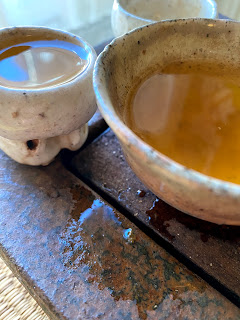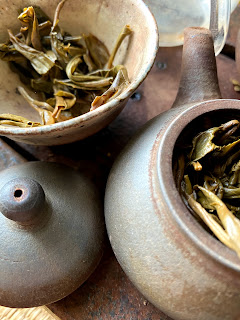There has long been a joke in Western puerh circles that almost
all Western puerh vendors and drinkers alike are made up of Western (often white)
males married to Oriental females. Yunnan Sourcing has Scott and Xiao Yao, The
Essence of Tea has David and YingXi, Crimson Lotus Tea has Glen and Lamu, there
are likely others... I suspect there are
likely many others as well where the Western male is the English voice of the
business but the oriental wife probably does lots behind the scenes, in these
instances they are just not as publicized.
Bucking the trend is Linda Louie at Bana Teas who perhaps is the only
female Western facing puerh-centric vendor as well.
I’m unsure what I want to say about that or how that might
be a reflection of the Western puerh drinking scene… but I can say that this
formulaic make up of most Western vendors likely has rather unconsciously
influenced and formed the current puerh drinking community / culture / created
the stereotypical puerh drinker (see mbanu comment) in
the West.
One of the things that I personally want to apologize about
and something that has been on my mind for quite a while is my tendency to
refer to these companies with the male owner exclusively (Example “Scott at
Yunnan Sourcing” “David of Essence of Tea”).
How many times have you heard this bias being perpetuated in the Western
puerh drinking scene? For me it is too
many and I really wanted to say something about that and at the very least say
“I’m sorry” for doing that in the past.
Another thing that I caught myself doing (and that I
apparently did above) and really everyone else does this and I’ve never read it
or heard it any other way… When the couple is listed together the white male is
always listed first followed by the Chinese woman. I know that a lot of people are going to be
thinking when reading this is that is simply the current convention- list he
man first then the woman. However, I
reject this passive explanation.
So I looked into the proper way to list couples to see if
there is some conventional way of writing this in the English language. Actually, there used to be a time when men
and woman had the same family name after marriage the woman would be listed
before the man. The reason was because in
matters of social correspondence women were more important traditionally. I never knew any of these old English
conventions! It turns out that there
really isn’t any proper way to list couples in English these days because these
old conventions are no longer followed.
Often, I have read, it is simply the one you are closest to that is
listed first.
I wonder if there is such a convention in traditional Chinese
culture? In traditional Taoist thought,
the order that things are written indicate the order of importance. Is Scott more important than Xiao Yao at
Yunnan Sourcing? Probably not. Is David more important than YingXi? Nope.
Recently, there was some who took issue with another gender
related issue in the puerh world- “The Mom Test”. Although, I think discussions about this were
interesting I kind of feel that there are maybe some deeper and longer running gender
inequality issues in the Western puerh world. I got to thinking about when and why that
naming convention really started (listing the male exclusively or the male
before the female)… I think part of the issue is that the white male was doing
most of the communication to the English Western facing world so naturally the
connection was made with him and then it was natural to list him first when writing
the couples name. Maybe when the correspondence
is done in Chinese maybe they use Xiao Yao’s name first? Or Ying Xi name before
David’s? I don’t know this.
I also don’t exactly know when Xiao Yao and Scott became
partners or when David began signing the website and emails with “David and
XingXi (Kathy)” but I don’t believe that they were doing that when they started
their businesses so I understand it isn’t completely an issue on my side of
things. Either way, I think it’s fair to
say that the part the Chinese woman play in these businesses are likely just as
important as the contributions of the Western male so it’s probably about time
that we recognize and acknowledge that by referring to the owners together.
I’m sorry for the times in this blog that I have not.
Peace













